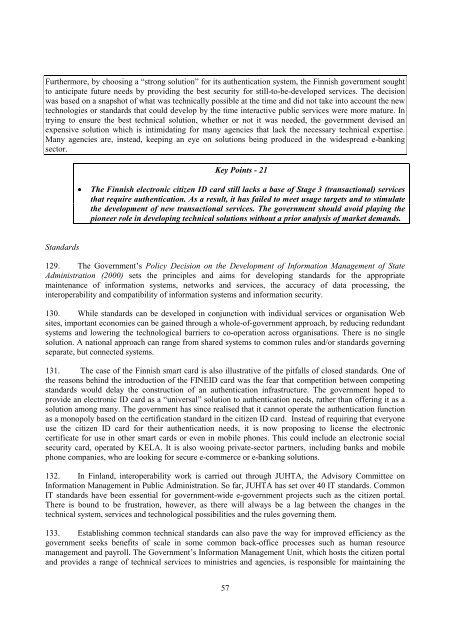e-GOVERNMENT IN FINLAND - ePractice.eu
e-GOVERNMENT IN FINLAND - ePractice.eu
e-GOVERNMENT IN FINLAND - ePractice.eu
You also want an ePaper? Increase the reach of your titles
YUMPU automatically turns print PDFs into web optimized ePapers that Google loves.
Furthermore, by choosing a “strong solution” for its authentication system, the Finnish government sought<br />
to anticipate future needs by providing the best security for still-to-be-developed services. The decision<br />
was based on a snapshot of what was technically possible at the time and did not take into account the new<br />
technologies or standards that could develop by the time interactive public services were more mature. In<br />
trying to ensure the best technical solution, whether or not it was needed, the government devised an<br />
expensive solution which is intimidating for many agencies that lack the necessary technical expertise.<br />
Many agencies are, instead, keeping an eye on solutions being produced in the widespread e-banking<br />
sector.<br />
Standards<br />
Key Points - 21<br />
x The Finnish electronic citizen ID card still lacks a base of Stage 3 (transactional) services<br />
that require authentication. As a result, it has failed to meet usage targets and to stimulate<br />
the development of new transactional services. The government should avoid playing the<br />
pioneer role in developing technical solutions without a prior analysis of market demands.<br />
129. The Government’s Policy Decision on the Development of Information Management of State<br />
Administration (2000) sets the principles and aims for developing standards for the appropriate<br />
maintenance of information systems, networks and services, the accuracy of data processing, the<br />
interoperability and compatibility of information systems and information security.<br />
130. While standards can be developed in conjunction with individual services or organisation Web<br />
sites, important economies can be gained through a whole-of-government approach, by reducing redundant<br />
systems and lowering the technological barriers to co-operation across organisations. There is no single<br />
solution. A national approach can range from shared systems to common rules and/or standards governing<br />
separate, but connected systems.<br />
131. The case of the Finnish smart card is also illustrative of the pitfalls of closed standards. One of<br />
the reasons behind the introduction of the F<strong>IN</strong>EID card was the fear that competition between competing<br />
standards would delay the construction of an authentication infrastructure. The government hoped to<br />
provide an electronic ID card as a “universal” solution to authentication needs, rather than offering it as a<br />
solution among many. The government has since realised that it cannot operate the authentication function<br />
as a monopoly based on the certification standard in the citizen ID card. Instead of requiring that everyone<br />
use the citizen ID card for their authentication needs, it is now proposing to license the electronic<br />
certificate for use in other smart cards or even in mobile phones. This could include an electronic social<br />
security card, operated by KELA. It is also wooing private-sector partners, including banks and mobile<br />
phone companies, who are looking for secure e-commerce or e-banking solutions.<br />
132. In Finland, interoperability work is carried out through JUHTA, the Advisory Committee on<br />
Information Management in Public Administration. So far, JUHTA has set over 40 IT standards. Common<br />
IT standards have been essential for government-wide e-government projects such as the citizen portal.<br />
There is bound to be frustration, however, as there will always be a lag between the changes in the<br />
technical system, services and technological possibilities and the rules governing them.<br />
133. Establishing common technical standards can also pave the way for improved efficiency as the<br />
government seeks benefits of scale in some common back-office processes such as human resource<br />
management and payroll. The Government’s Information Management Unit, which hosts the citizen portal<br />
and provides a range of technical services to ministries and agencies, is responsible for maintaining the<br />
57
















